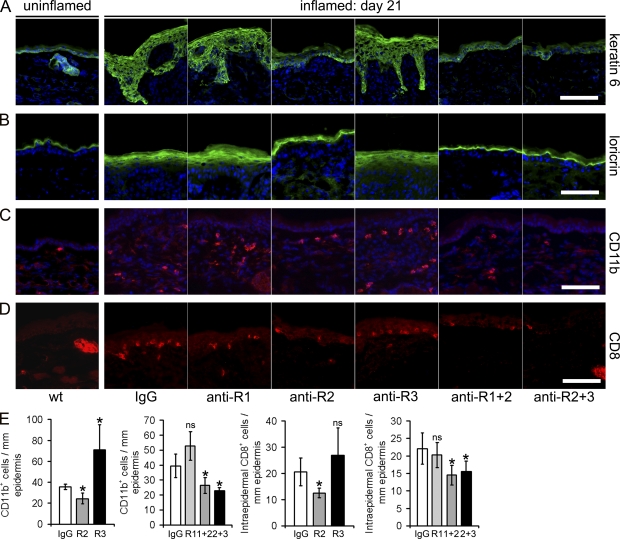Figure 5.
Systemic blockade of VEGFR-2 results in normalized epidermal differentiation and reduced inflammatory skin infiltration. (A and B) Immunofluorescence analyses of ear skin sections from normal wild-type mice show that the hyperproliferation-associated keratin 6 is only faintly expressed in the normal interfollicular epidermis and is largely restricted to the hair follicle (A). Loricrin, a marker of terminal epidermal differentiation, is restricted to the upper granular layer in normal mouse skin (B). At day 21 of chronic skin inflammation in control IgG-treated mice, keratin 6 and loricrin show a much broader expression pattern. Inhibition of VEGFR-2 (anti-R2), alone or in combination with inhibition of VEGFR-1 or VEGFR-3, largely normalized keratin 6 and loricrin expression patterns. Treatment with anti–VEGFR-1 or anti–VEGR-3 showed no major effect. (C and E) CD11b+ cells are rarely found in normal mouse skin (wt). The number of CD11b+ cells was increased in the inflamed skin of control IgG-treated mice and was decreased after the inhibition of VEGFR-2, VEGFR-1+2, or VEGFR-2+3 but not after inhibition of VEGFR-1. Inhibition of VEGFR-3 resulted in enhanced numbers of CD11b+ cells. (D and E) Inhibition of VEGFR-2, VEGFR-1+2, and VEGFR-2+3 strongly decreased the number of intraepidermal CD8+ T-lymphocytes, whereas the inhibition of VEGFR-1 or VEGFR-3 had no effect, as compared with IgG-treated mice. Bars, 100 µm. (E) Computer-assisted quantification of the numbers of CD11b+ and CD8+ cells per millimeter of epidermal basement membrane. n = 5 mice per group. Two independent experiments were performed. Data represent mean ± SD. *, P < 0.05. ns, not significant.

